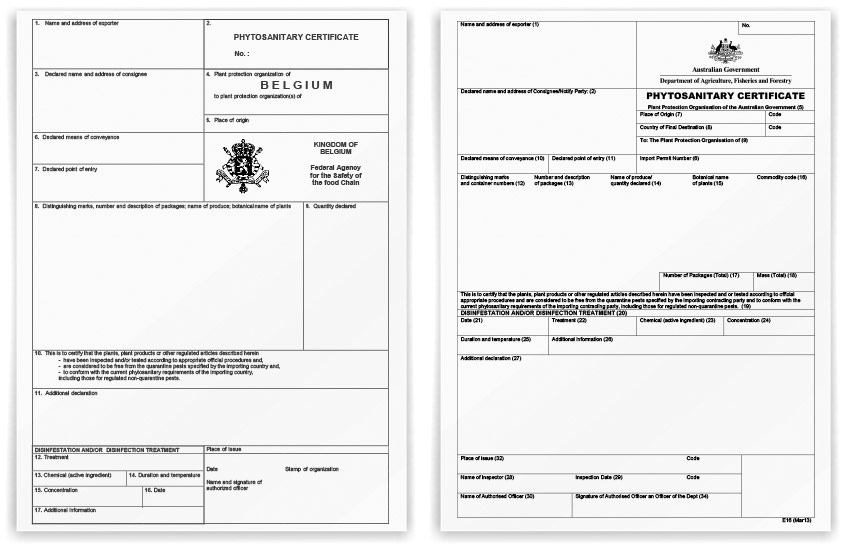Lesson 2: Creating the Phytosanitary Certificate Using the Certification Process
Topic 4: Step 4: Complete the Appropriate Certificate
Here you will learn about the final step in creating and issuing a phytosanitary certificate. If the export consignment has cleared all of the previous steps, it is now time to complete the actual certificate. In this topic, you will be provided with guidance on creating and filling out a phytosanitary certificate.
Objectives:
- Participants will understand the IPPC’s requirements for information that must be included in every certificate.
- Participants will recognize different ways of constructing their NPPO’s phytosanitary certificate.
- Participants will see the similarities between an original phytosanitary certificate and a certificate for re-export.
The purpose for issuing phytosanitary certificates and phytosanitary certificates for re-export is to confirm that the consignments meet specified phytosanitary import requirements and conform with the certifying statement of the certificates. The certificates should only contain relevant phytosanitary information and should clearly identify the consignment to which it relates. ISPM 12 provides a basic certificate model along with explanations of the various information components that are required for the certificate. Every country uses the ISPM 12 model certificate to create the phytosanitary certificate specific to their country.
Even though the phytosanitary certificate form is very similar across the world, every country has their own method and process for issuing and tracing phytosanitary certificates. A country’s methods and processes for issuing and tracing phytosanitary certificates reflect the nation’s needs and circumstances. For example, large countries with numerous exporters, frequent shipments, and multiple plant protection personnel need sophisticated, online electronic databases so that certificates do not get lost. In contrast, a small country with a more manageable number of exporters may only need a simple offline database. No matter the method used, it must allow the country’s NPPO to accurately maintain complete records of all certificates issued. Most countries have some version of an electronic system to keep accurate records and allow for accurate tracking and trace back. Your NPPO will need to develop a record system that works for your circumstances.
In the U.S., PPQ form 577 (phytosanitary certificate) and PPQ form 579 (phytosanitary certificate for re-export) are normally issued through the USDA’s Phytosanitary Certificate Issuance and Tracking (PCIT) system. PCIT is a web-based system that automates the issuance of phytosanitary certificates, maintains records, facilitates trace backs, and authenticates/validates US certificates via the PCIT certificate viewer.
The Components of the Phytosanitary Certificate
A phytosanitary certificate is used to certify shipments that originated within a country, which are being now shipped to an importing country. ISPM 12 provides a basic form that an NPPO may use or elaborate on for the needs of its country. You may want to turn to pp. 162–164 in your copy of ISPM 12 for this exercise.
We have used the barumba berry example to fill out the generic form below. Again, be aware that methyl bromide fumigation treatment is only used to illustrate our example and is being phased out of use globally. Use your mouse to click on the highlighted boxes on this screen below to learn more about why the information is important to include and the possible real-world consequences if the information is missing. Also look at the ISPM explanation for each box of the certificate in order to read about what information should be included and where the information comes from.
Phytosanitary Certificate Examples
Now that you understand the underlying principles and components of a PC, we have provided examples of real PC forms from a few countries. Please look at the following examples from Australia and Belgium. Note how each certificate has at least the minimal information included. Some of the examples have additional information included.

Every country has a slightly different format for their phytosanitary certificates, but as you can see, they are all based on the original model from ISPM 12. These forms have been created according to that country’s preferences and needs. However, all certificates have the same information you see in the ISPM 12 form included within the different document layouts.
Components of a Re-export Certificate
Situations sometimes arise where the final use of an export will not be domestic and all, or parts, of the original shipment need to be exported again. Re-export certificates can be very useful in these situations because it allows for the certification of unprocessed plants and plant products of foreign origin rather than domestic where a phytosanitary certificate would be issued. A re-export certificate is also used for blended commodities of both foreign and domestic origin for export. The components and principles of a phytosanitary certificate (PC) for re-export are based on the same rationale as the PC, thus you will notice they are nearly identical. In fact, some countries just add a modified section to their existing PC.
In this modified certification section, the NPPO, by inserting ticks in the appropriate boxes for several different circumstances, indicates
- whether the certificate is accompanied by the original phytosanitary certificate or its certified copy,
- if the consignment has been repacked,
- if the containers are original or new, or
- whether an additional inspection has been done.
All of this information is necessary because it may affect the phytosanitary status of the shipment. Imagine a shipment sitting in a warehouse or in a train car. When you consider the environment where shipments are stored, there could be opportunities for exposure to pests. Therefore, additional actions must be taken to maintain the phytosanitary status.
For example, sometimes a consignment is split up and re-packed and then recertified and exported separately. Re-packaging would potentially expose the commodity to new pests. In this situation, phytosanitary certificates for re-export and certified copies of the original phytosanitary certificate would accompany any such consignments.
Here is an example of a phytosanitary certificate for re-export issued by the United States (PPQ form 579). This is an example of a manual or paper form and was not generated by the PCIT system. Manually generated PCs must be distributed and records maintained according to PPQ guidelines; this is somewhat time consuming. Distributing the certificate and maintaining the record is done automatically if using the PCIT system.

How could these principles be applied to our berry example? Perhaps Bob’s Grocery and Wholesale sees an opportunity to repackage their recently imported berries with some locally grown melons in mixed fruit containers. If they then exported the mixed fruit to a third country, or even back to Exportland, a phytosanitary certificate for re-export would be necessary.
In this topic, you learned about the actual phytosanitary certificate. Every country has a slightly different format, but every certificate includes information required by the IPPC. At minimum, you must include the required information and then anything else you choose to add will be based on the needs of your NPPO. Finally, you must have a reliable way to file the certificate information so that trace back and tracking can easily be done.
To continue, select Lesson 3 from the Topics menu above or click here.
